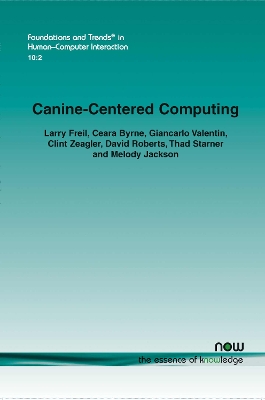Foundations and Trends (R) in Human-Computer Interaction
1 total work
Canine-Centered Computing
by Larry Freil, Ceara Byrne, Giancarlo Valentin, Clint Zeagler, David Roberts, Thad Starner, and Melody Jackson
Published 30 April 2017
Canines and humans have lived together for many thousands of years, to our mutual benefit. In addition to providing companionship, dogs can perform critical roles, such as assisting humans with medical concerns, searching for lost individuals, and detecting substances by scent. Researching how technology might be designed for canines has the potential to significantly improve the lives of both dogs and humans.
Canine-Centered Computing examines the history and the current state of the art in this nascent field. It draws upon the extensive foundations and literature in human-centered computing to identify and adapt models and methods that are relevant for canines. It surveys the landscape of canine-centered computing and canine psychophysics, and generates a framework and set of guidelines to help inform the requirements, design, and evaluation of systems for canines.
Canine-Centered Computing provides a foundation that will enable an HCI researcher or practitioner who is familiar with HCI theory, models, and methods to understand and contribute to this promising nascent field.
Canine-Centered Computing examines the history and the current state of the art in this nascent field. It draws upon the extensive foundations and literature in human-centered computing to identify and adapt models and methods that are relevant for canines. It surveys the landscape of canine-centered computing and canine psychophysics, and generates a framework and set of guidelines to help inform the requirements, design, and evaluation of systems for canines.
Canine-Centered Computing provides a foundation that will enable an HCI researcher or practitioner who is familiar with HCI theory, models, and methods to understand and contribute to this promising nascent field.
